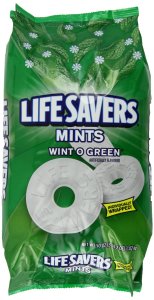 Imagine a dark room. A closet. With a friend. Your friend pulls out a circular-like object out of their pocket and they whisper to you “Let’s do it.” Nervously, you accept your partners offer. You then proceed to do it. You stick the circular-like object into your mouth and then Boom! Crackle! Pow! Sparks start to fly and your mouth seems to be glowing. What was that?! Your friend then smiles at you, “that my friend was The Wint-O-Green Saver Effect.”
Imagine a dark room. A closet. With a friend. Your friend pulls out a circular-like object out of their pocket and they whisper to you “Let’s do it.” Nervously, you accept your partners offer. You then proceed to do it. You stick the circular-like object into your mouth and then Boom! Crackle! Pow! Sparks start to fly and your mouth seems to be glowing. What was that?! Your friend then smiles at you, “that my friend was The Wint-O-Green Saver Effect.”
You are probably extremely confused, but the fact is that Life Saver candies may shoot sparks out of your mouth in the pitch black. Besides being a totally awesome discovery, this provides scientists with a better understanding on how things break on an atomic level(Chang 1). According to scientists at the University of Illinois at Urbana-Champaign, “…those faint sparks were energetic enough to power chemical reactions along the fracturing surfaces”(Chang 1). In other words, the effect of biting down on a Life Saver is so strong that you can see the sparks flying out of your mouth. Professor of Chemistry at Illinois, Kenneth S. Suslick, claimed that the sparks from the Life Savers gave him the bold opportunity to perform spectroscopy, the study of interaction between matter and radiated energy(Spectroscopy 1). He would use this study to find specified colors of light that were given off by various atoms and molecules(Chang 1).
The technical term for the interaction between ones mouth and the Life Saver is called triboluminescence, “light produced by rubbing”(Chang 1). This term was founded by an English Philosopher, Sir Francis Bacon, in the early 1600’s(Chang 1). He expressed his findings in the “Novum Organum” in 1620, concluding that “It is also most certain that all sugar, whether refined or raw, provided only it be somewhat hard, sparkles when broken or scraped with a knife in the dark.”
Triboluminescence is the back-bone behind this discovery. In scientific terms, in sugars or quartz crystals, electrons build up which causes fracturing and chemical bonds to break(Chang 1). These “electrons jump to nitrogen or oxygen molecules in the air, which shed the excess energy by emitting light”(Chang 1). Since the Life Savers have oil of wintergreen (methyl salicylate) to flavor them, it is easy to witness the The Wint-O-Green Saver Effect(Chang 1).
If you want to try out this phenomenon yourself go right ahead! All you need is a dark room, a mirror, a Winter-Green Life Saver, and maybe a buddy for company! All you do is throw the sucker into your mouth and hold the mirror up to your face and chew! Watch the magic happen as your mouth begins to bubble and sparkle with various colors(Lightning 1). It is lightning in your mouth.
So what do you think?
Works Cited
Chang, Kenneth. “Sweet Spark May Hold Clue to How Things Break.” The New York Times. The New York Times, 18 June 2007. Web. 26 Nov. 2014.
“Lightning In Your Mouth.” Https://www.exploratorium.edu. Science Of Cooking, n.d. Web.
“Spectroscopy.” Wikipedia. Wikimedia Foundation, 26 Nov. 2014. Web. 26 Nov. 2014.




